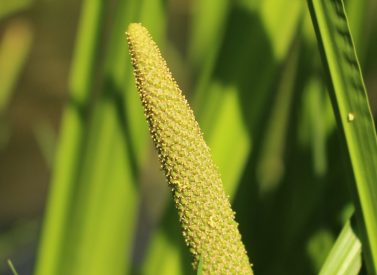Scientific Name: Acorus calamus
Constituents:
- Volatile oils (sequiterpenes and monoterpenes: acorenone, isocalamendiol, α-and β-asarone (content varies greatly with species and habitat), α-and β-pinenes, myrcene, p-cymene, phellandrene-β, terpinene-γ, terpinolene, thujane and limonene.
- Saponins (steroidal glycosides)
- Mucilage
- Bitter principle (acorin, acoretin)
- Lignans (epieudesmin, galgravin)
- Tannins
- Resins
Medicinal actions:
- Analgesic
- Anthelmintic (Antiparasitic)
- Anti-lithic
- Antioxidant
- Antimicrobial (Antifungal & Antibacterial)
- Antispasmodic
- Carminative
- Diuretic
- Emmenagogue
- Euphoric
- Expectorant (Bronchodilator)
- Hypotensive
- Immunosuppressant
- Nervine stimulant
Mechanism of Action & Pharmacology:
- Volatile oils affect the digestive, circulatory, nervous, and respiratory systems. Anticholinergic activity, calcium channel blockade, and phosphodiesterase inhibition (specifically PDE4) may provide possible pharmacological basis for use in the relaxation of airways and in conditions such as asthma.
- Mucilage & saponins increase expectoration and are theorized to act as a relaxant and antispasmodic to the lungs from the digestive tract through the spinal reflex.
Pharmacy:
- Powder
- Decoction in water or milk, honey often added
- Tincture
- Topical: as paste or plaster
Safety & Toxicity Concerns:
- Not for long-term use.
- Large doses may cause nausea and/or vomiting and tachycardia.
- Avoid during pregnancy due to possible emmenagogue effects.
- Use caution in immunocompromised individuals.
- Note: Much of research on the pharmacology of A. calamus centers on the VO asarone which is considered carcinogenic. However, the American variety of the species does not appear to include asarone in meaningful amounts, instead having sesquiterpenes as part of its volatile oil composition and is thus considered safer to use.
Interactions:
- Theoretical additive effects with immunosuppressant, hypotensive or hypoglycemic agents.








